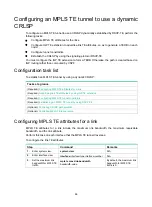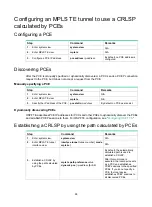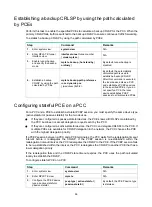
90
Step Command
Remarks
7.
Configure the MPLS TE
tunnel interface to use the
explicit path, and specify a
preference value for the
explicit path.
mpls te path preference
value
explicit-path
path-name
[
no-cspf
]
By default, MPLS TE uses the
calculated path to establish a
CRLSP.
Establishing an MPLS TE tunnel by using RSVP-TE
Before you configure this task, you must use the
rsvp
command and the
rsvp enable
command to
enable RSVP on all nodes and interfaces that the MPLS TE tunnel traverses.
Perform this task on the ingress node of the MPLS TE tunnel.
To configure RSVP-TE to establish an MPLS TE tunnel:
Step Command
Remarks
1.
Enter system view.
system-view
N/A
2.
Enter MPLS TE tunnel
interface view.
interface tunnel
tunnel-number
[
mode
mpls-te
]
N/A
3.
Configure MPLS TE to use
RSVP-TE to establish the
tunnel.
mpls te signaling rsvp-te
By default, MPLS TE uses
RSVP-TE to establish a tunnel.
4.
Specify an explicit path for
the MPLS TE tunnel, and
specify the path preference
value.
mpls te path preference
value
{
dynamic
|
explicit-path
path-name
}
[
no-cspf
]
By default, MPLS TE uses the
calculated path to establish a
CRLSP.
Controlling CRLSP path selection
Before performing the configuration tasks in this section, be aware of each configuration objective
and its impact on your device.
MPLS TE uses CSPF to calculate a path according to the TEDB and constraints and sets up the
CRLSP through RSVP-TE. MPLS TE provides measures that affect the CSPF calculation. You can
use these measures to tune the path selection for CRLSP.
Configuring the metric type for path selection
Each MPLS TE link has two metrics: IGP metric and TE metric. By planning the two metrics, you can
select different tunnels for different classes of traffic. For example, use the IGP metric to represent a
link delay (a smaller IGP metric value indicates a lower link delay), and use the TE metric to
represent a link bandwidth value (a smaller TE metric value indicates a bigger link bandwidth value).
You can establish two MPLS TE tunnels: Tunnel 1 for voice traffic and Tunnel 2 for video traffic.
Configure Tunnel 1 to use IGP metrics for path selection, and configure Tunnel 2 to use TE metrics
for path selection. As a result, the video service (with larger traffic) travels through the path that has
larger bandwidth, and the voice traffic travels through the path that has lower delay.
To configure the metric type for tunnel path selection:
Step Command
Remarks
1.
Enter system view.
system-view
N/A
2.
Enter MPLS TE view.
mpls te
N/A
















































